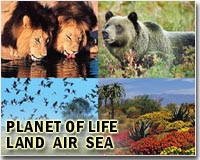| . |  |
. |
Davis CA (SPX) Feb 08, 2011 Conservationists across the United States are racing to discover a solution to White-Nose Syndrome, a disease that is threatening to wipe out bat species across North America. A review published in Conservation Biology reveals that although WNS has already killed one million bats, there are critical knowledge gaps preventing researchers from combating the disease. WNS is a fatal disease that targets hibernating bats and is believed to be caused by a newly discovered cold-adapted fungus, Geomyces destructans, which infects and invades the living skin of hibernating bats. Since 2006 about one million bats across six species in eastern North America have died from WNS, and as a result several species of bats face endangerment or extinction. "White-Nose Syndrome was first documented in 2006 in a tourist cave near Albany, New York. Dead and dying bats were then found in four nearby caves, 30 km west of Albany," said lead author Janet Foley from the University of California, Davis. "By July 2010 G.destructans was identified in hibernating bats in 13 states as well as in Ontario and Quebec across the Canadian Border." Affected bat species include the endangered Indiana and gray bats (Myotis sodalis and M. grisescens), little brown bat (M. lucifugus) and the cave bat (M. velifer). Infection has also been confirmed in five species of bats in Europe, although no similar epidemic has yet been recorded. The low temperatures and humid conditions of bat caves create ideal breeding grounds for this fungus, and in some bat colonies the mortality rate from WNS has been more than 95%. "Some bats in infected bat colonies behave abnormally when infected, choosing to hibernate in exposed places, such as cave entrances or even flying during the day," said Foley. "Bats regularly arouse from hibernation in order to drink, urinate and relocate. This causes them to burn up their only source of energy during winter, the body fats they stored prior to winter when insect prey was still available. Fungal infection might be leading to more frequent arousals from hibernation, causing infected bats to use up their fat reserves earlier, with potentially fatal consequences." Although the effects of the disease are all too apparent, there are critical knowledge gaps for researchers confronted with combating the disease. It remains unclear if G. destructans is the only pathogen involved, how it causes mortality, and its means of transmission. Some evidence suggests that people can move the fungus from cave to cave. "Our study considers how epidemiology and disease ecology can help fill these knowledge gaps," said Foley. "We believe that a roadmap including bat monitoring and disease surveillance, coupled with active research into finding ways to treat individual bats will be vital to combating this disease." "Based on current data, we believe that the culling of bats would be both premature and ill-advised. Instead we see efforts to conserve the genetic diversity of bat populations, combined with a program of educating the public to be key parts of the roadmap." Dr Foley's team includes bat and disease ecologists from three different public agencies and academia and tries to make the point that creative, scientifically-sound ideas will be key to the success of any management plans. The group outlines an outbreak investigation framework that includes establishment of diagnostic standards, case definitions, and gathering of information on potential treatments for similar diseases. The importance of monitoring bat population health is also stressed, as is improving public education and awareness of the disease, especially as many species of bats live in caves popular among tourists. If current declines in bat populations continue, the researchers expect strong reductions in the ability of bats to reduce insect pests and play important ecological roles in unique cave ecosystems. The team also called for further studies of the chemical or biological agents that can kill the fungus, but have yet to be proven safe for bats. "In the three years since its discovery WNS has changed the focus of bat conservation in North America," concluded Foley. "A national response is required and our epidemiological roadmap is designed to help inform state and national efforts to combat WNS across North America."
Share This Article With Planet Earth
Related Links University of California, Davis Darwin Today At TerraDaily.com
 Rare mountain gorilla twins born in Rwanda
Rare mountain gorilla twins born in RwandaKigali (AFP) Feb 7, 2011 A mountain gorilla in northern Rwanda gave birth to twins, a rare occurrence for an endangered species which counts fewer than 800 individuals, Rwandan media reported Monday. "The twins, both of them males, were born Thursday of a mother gorilla called Kabatwa. They are doing well," Radio Rwanda reported, quoting information from the Rwandan Development Bureau. According to the pro-gover ... read more |
|
| The content herein, unless otherwise known to be public domain, are Copyright 1995-2010 - SpaceDaily. AFP and UPI Wire Stories are copyright Agence France-Presse and United Press International. ESA Portal Reports are copyright European Space Agency. All NASA sourced material is public domain. Additional copyrights may apply in whole or part to other bona fide parties. Advertising does not imply endorsement,agreement or approval of any opinions, statements or information provided by SpaceDaily on any Web page published or hosted by SpaceDaily. Privacy Statement |